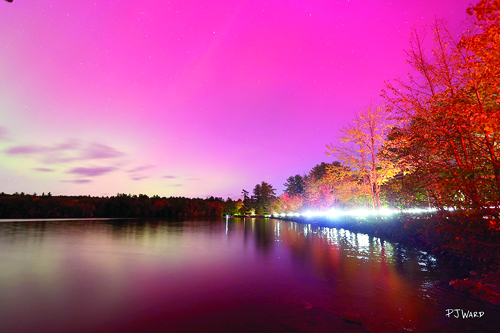In Ye Olden Times: The Founding Auroras of 1819

By Micheal Davis
BN Columnist
Howdy neighbor!
Well now, it was just back in May that I wrote up a great little column on the Northern Lights, owing to the spectacular display of them we experienced last spring — and now here Nature goes again, before the year is even out, she throws us an even better display these past few nights than we had five months ago.
As I said at that time, the display of last spring featured “more auroras sporting in the skies over Bridgton, and indeed all of Maine, than I’ve seen in my lifetime,” and I still stand by that assessment today, owing to the long period over which the vernal display lasted. But as for the brilliancy of the fires this past week, well… I do believe they were brighter, and burned in even greater brilliancy. Truly, they were something else, a sight to see and one which I shall never forget.
While last spring I looked back through the archives and found a relatively recent account from the 1980s to feature, even saying at the time that I don’t always want to go back to some obscure part of the 19th century for my material, I must admit that certainly do enjoy doing that and I think it’s what most of our readers here have come to expect from me. So today, that’s exactly what we’re doing, as we look back over two centuries to the very founding days of the great state of Maine, to try to recover insight into certain miraculous celestial phenomena which attended the birth of our state; signs which much like the guiding star of Bethlehem, so too heralded the coming of a new age. Yes, indeed folks, hold on to your hats as we dig back into the marvels that I’m calling “The Founding Auroras.”
Now to start off with, I don’t think the following facts are very widely known, which honestly surprises me because this feels like the sort of history we ought to be teaching our youngsters in civics class. Yet it remains a little-acknowledged fact in Maine’s history, that were born under a most auspicious star. It happened in 1819, when after six referenda held over several decades, finally the good people of Maine at last voted to separate ourselves from the mother state of Massachusetts; declaring the District of Maine was, and of right ought to be, a free and independent state, to borrow a line from the Declaration. After this vote for independence was passed, which was in July, it next followed that Maine required a constitution all our own, for we couldn’t very well get by with a mere copy of Massachusetts’ any longer. We wanted the freedom to chart our own destiny, to establish and enshrine our own rights, to tend our own affairs without the say or influence of Boston and its people – a sentiment which remains as true today as ever! — and so at length a convention was called to be held in Portland to draft and frame the constitution for our new state. It lasted from October 11 to October 29, when at last the ink was dry on what proved to be the Constitution later adopted. Phineas Ingalls was there representing Bridgton. While there he, together with all his fellows from across the state, bore witness to a remarkable heavenly omen foretokening the great promise of their labors; the eruption of a great and fiery aurora across the northern heavens, which some held to be indicative of the virtue of their work in the eye of Divine Providence. As later remarked by the editors of the Portland Gazette of August 8, 1820: “During the sitting of the Convention which met at Portland to frame the Constitution of Maine, some very brilliant Auroras occurred; and on the 3rd, April, when the people assembled to exercise their first act of authority, under the constitution, a fresh play of Northern Lights, of a more remarkable kind, took place, and was followed by a series of others, less striking, the succeeding ten nights.”
What a marvel! Not only did we see a display in late October of 1819 when the Constitution was written, we also had another, even greater set in April, 1820 when at last the people met to vote under the Constitution, and with it elect the first Governor of the new state of Maine. Talk about a good omen!
It was so good in fact, that the man who designed the Maine State Seal, Dr. Benjamin Vaughan of Hallowell, proposed that under and about the star on the proposed design, which is of course the guiding North Star, there also be proclaimed the encircling glow of those Northern Lights which had smiled so benignantly over our state’s birth. As he wrote in his proposal for the design later adopted: “Below this north star, a bow will be seen crossing the paper – This is a luminous bow, such as is occasionally seen as a portion of the aurora borealis or northern lights; and to ascertain this to be its nature, clusters of rays issue from its northern side, as in fact often happens in the heavens. This emblem has no necessary reference in our plan to our geographical position; but chiefly regards a more pointed circumstance. When the convention for forming the Constitution of Maine was sitting in Portland, in October last, the appearances of the Aurora were brilliant and frequent; and their visit was repeated in a splendid manner on April 3rd, when we chose our Governor and Legislators; being followed by a number of fainter traces of light within the next ten nights. It has seemed therefore interesting to record what is significant as an emblem, and may to many seem encouraging as an event.”
Ultimately, this design would be modified at committee; Vaughan’s proposed state motto, “I saw in the way a light,” from Paul’s address to Agrippa was of course declined in favor of the more succinct and inspiring “Dirigo” or “I lead,” in itself a reference to the North Star over the Auroras.
I see in the current seal, and especially in its earlier drawn incarnations over the years, a tendency to include portions of the old auroral design proposed in 1820. Even on the modern rendition the North Star is still surrounded by an arc or band of outward streaking lines – clearly radiating beams of light. Nowadays, this device appears as a five-pointed pentagram of rays seemingly issuing out of the star itself, but in earlier renditions from the mid 1800s, especially that of the 1822 militia flag, this band of light evinced a tendency to appear as an arc, very similar indeed to the “luminous bow” of “clusters of rays” about the star which Vaughan clearly states was meant to credit the presence of those fateful auroras which attended the happy birth of our state.
They were an incredible display on which much import was placed, and as we find from the editors of the Gazette, the inclusion of the auroras on our seal and standard were deemed a device “well suited to the most Northern State of the Union, and contained an historical reference after the manner of the legislators of old, who have endeavored to weave notable accidents in the history of the foundation of their institutions.”
I, for one, am sad that in the intervening two centuries the gradual revision of our state seal through successive official artworks by disparate artists have slowly moved it away from the vision expressed in the original design. Many things have changed, some elements have been reduced or lost entirely, but no change do I feel as keenly as the loss of that auroral arc stretching over the state and below the stars, even as the auroras themselves range in fitful glory across that great gulph betwixt earth and heaven. Looking at the seal today I feel their absence, but reflecting on this I do find the ironic comfort that in any event, they were meant to be there, and so even if they only appeared on our seal very briefly before fading away all too soon, and leaving only the stars behind them – isn’t that, after all, exactly what an aurora should do? It’s in their nature; they don’t stay, they don’t last, and of course the beauty in them is all because they don’t last. Only our memories do, and what they meant to those who saw them. Like this sign of old, I will remember our recent auroras a very long time indeed.
Till next time!

